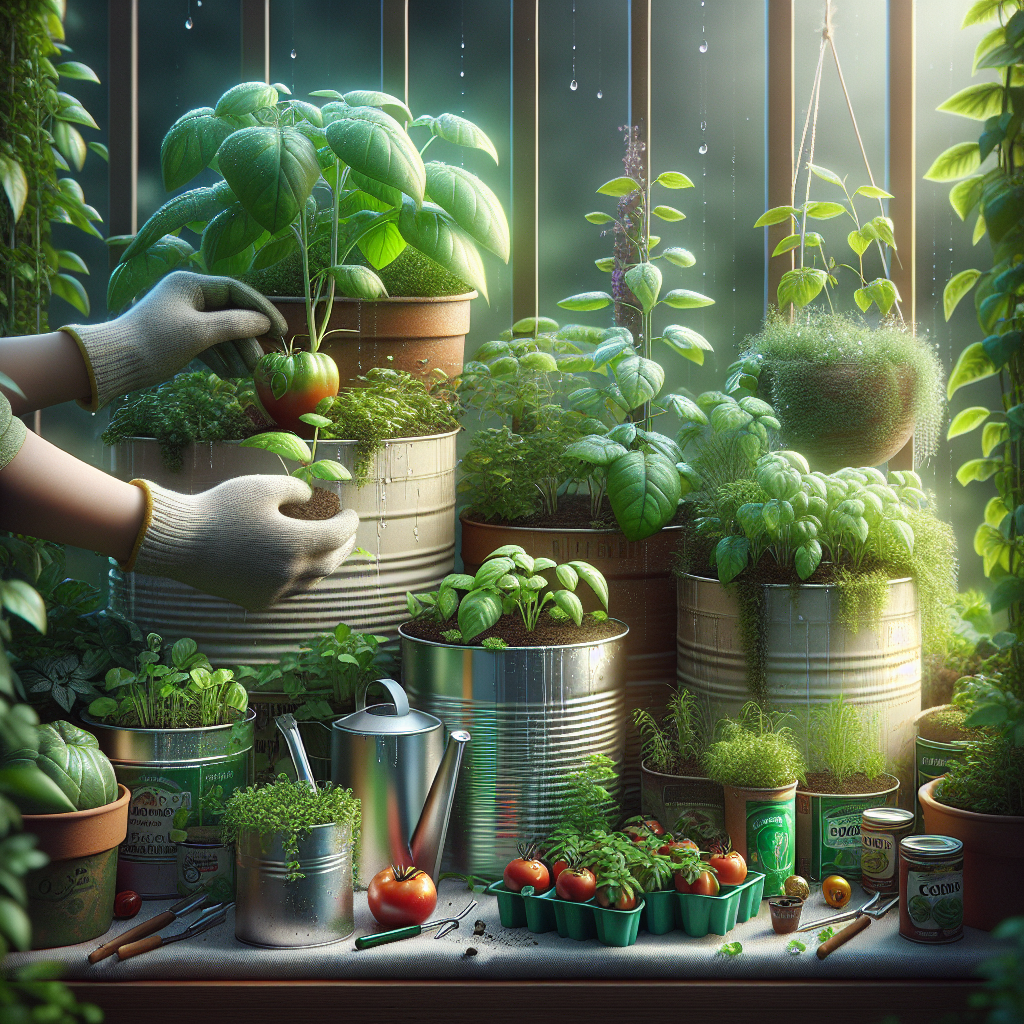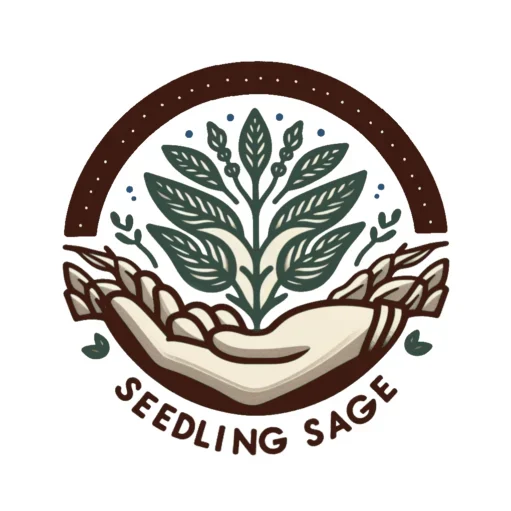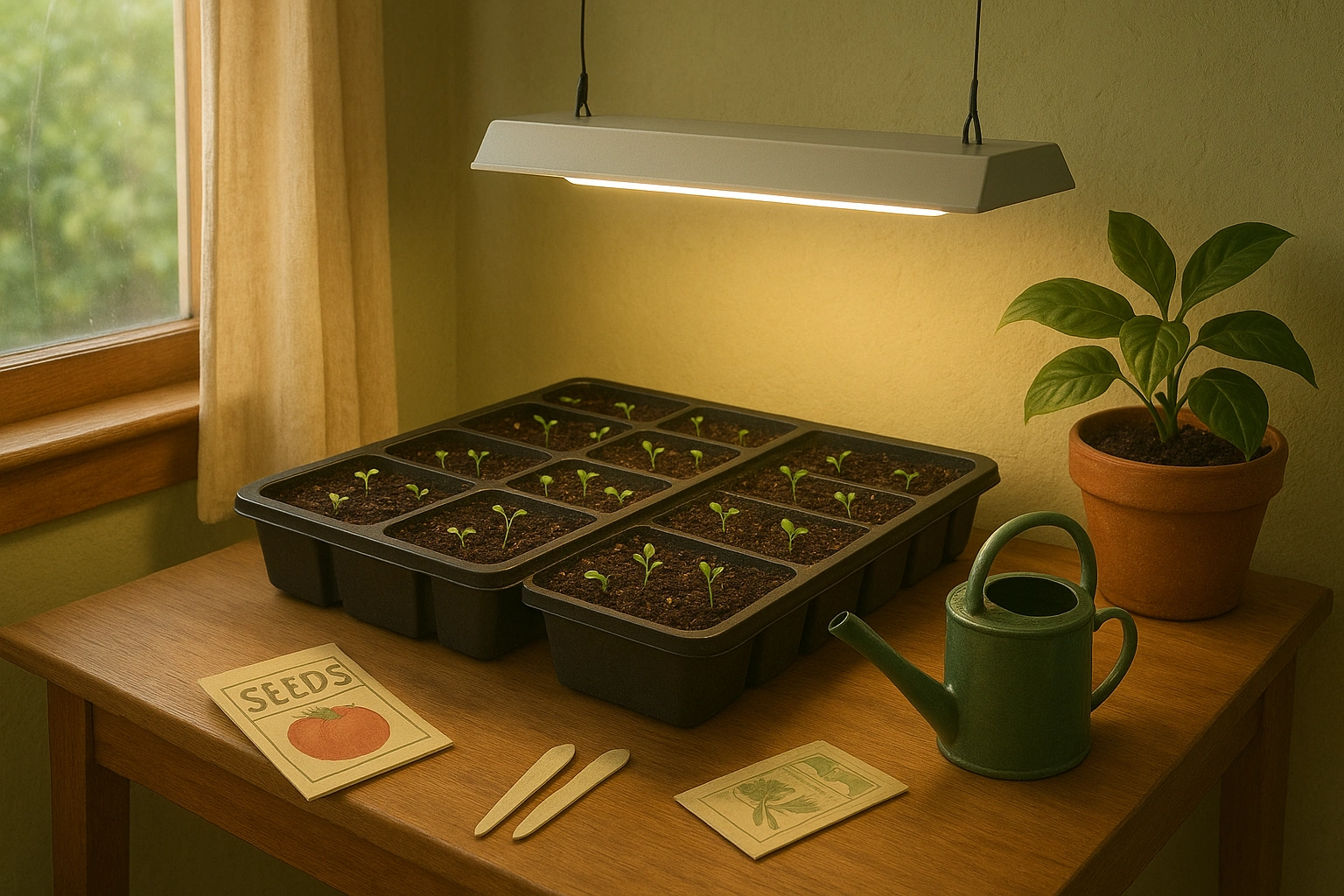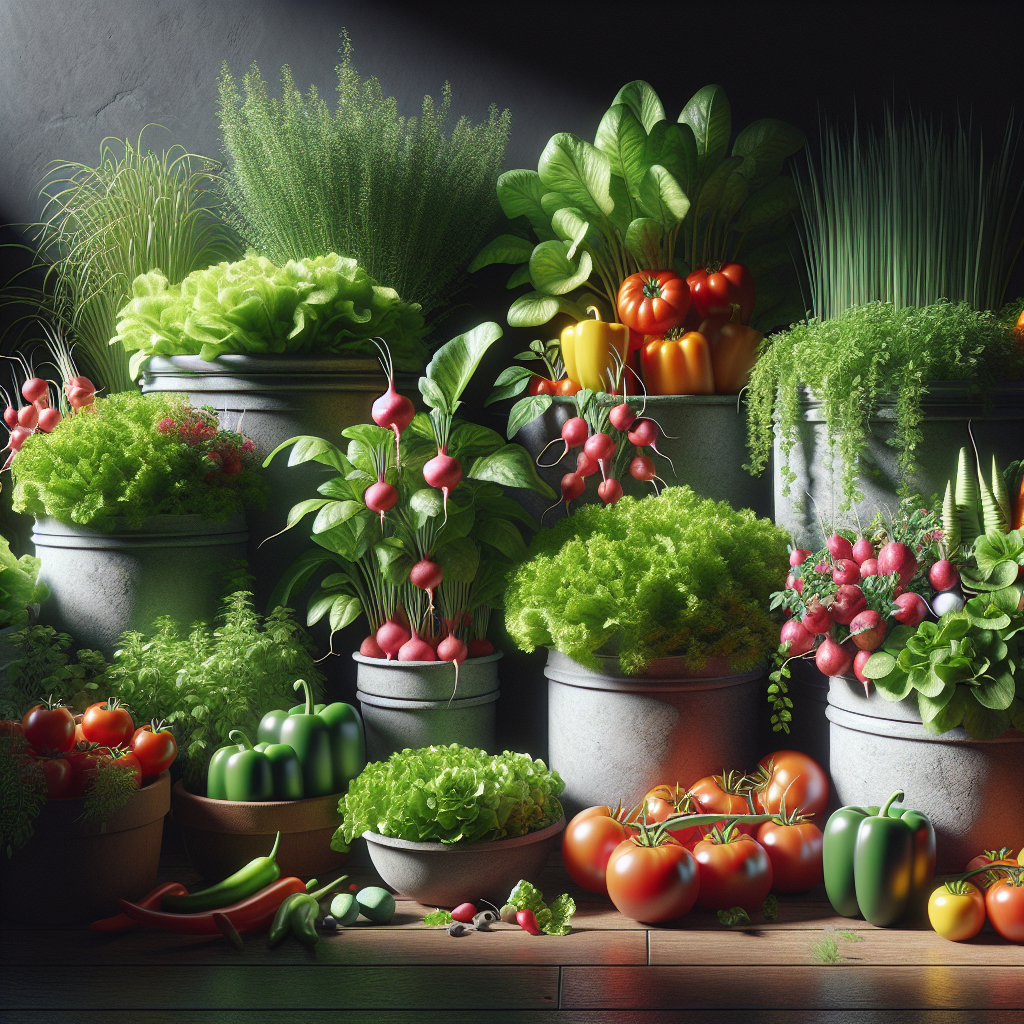Nurturing Nature: Tips and Tricks for Successful Organic Container Gardening
November 6, 2024 | by Emma Sage

ORGANIC CONTAINER GARDENING FOR BEGINNERS
13 min read
Join me in exploring organic container gardening for beginners and create your own green oasis, no yard needed!
Beginning Organic Container Gardening
Introduction to Container Gardening
I discovered container gardening to be a fabulous way to grow food and flowers, even if you’re working with a small plot of land—or no land at all. Anything you can plant in the ground usually does just as well in a pot, so this is perfect for beginners or folks living in tight quarters. If you, like me, are short on gardening space because you’re living in an apartment with only a tiny balcony or your backyard dirt is as welcoming as a rock pile, then containers might be your new best pals. You can manage your plants’ little world in pots, moving them for some sweet sunshine or safe-guarding them during nasty weather.
Here’s a nifty comparison of why container gardening could be just what you need:
| Why You’ll Love Container Gardening | What’s Great About It |
|---|---|
| Makes the Most of Little Spaces | Just right for cozy balconies and small patios |
| Swappable | Shift pots around for best light and storm protection |
| Easy to Start | Perfect for newbies and gardening greenhorns |
| Personalization | Grow what tickles your fancy or matches your decor |
Benefits of Organic Container Gardening
Now, if you kick things up a notch and go organic with your container gardening, you’re stepping into an even better realm. Toss out the chemicals and dodgy fertilizers! Instead, think about nourishing plants the natural way, which is better for you and Mother Earth. This method not only fills my plate with fresh veggies but also lets me live a more eco-friendly lifestyle.
Check out some perks of keeping it organic with your container gardening:
- Plants With a Healthy Glow: Organic soil and natural fertilizers keep nasty chemicals out, promoting thriving soil and robust plants.
- Easy Peasy to Start: You just need the basics—pots, soil, plants, natural fertilizers, and some water. It’s so simple, anyone can jump in.
- Adapt to Any Setting: Your garden, your way, whether you’re planting on a balcony, a deck, or even inside your pad. Let your style and fave plant colors shine.
- Eco-Friendly: Going organic means you’re doing your part for the planet and keeping the carbon nasties low.
Whipping up my own organic soil mix is pretty straightforward, ensuring drainage and preventing waterlogged disasters. Try mixing 5 gallons of compost, 1 gallon of sand, 1 gallon of perlite, and a cup of an all-purpose granular organic fertilizer to treat your plant babies to a nutritious feast (Gardening Know How).
Diving into organic container gardening has been not just rewarding but a real hoot, letting me grow what I eat and pretty up my space while being kind to the environment. For more juicy tips, you might want to look into organic vegetable container gardening or dig into best organic soil for container gardening.
Container Gardening Essentials
Starting my own little green oasis in pots has been a joyride. Here’s some of the wisdom I’ve picked up on picking the right containers and organic dirt mixes to get your garden growing.
Choosing the Right Containers
First thing I learned in my pot plant exploits was how to pick the proper containers. Turns out, the stuff your container’s made of is key to your plant babies’ health. You’ll want something safe, with holes in the bottom for water to escape, and enough room for roots to stretch. Here’s a quick rundown of some common container materials I checked out:
| Material | Pros | Cons |
|---|---|---|
| Clay | Breathable, looks nice in your space | Can break with frost |
| Plastic | Light, cheap | Not great for airflow |
| Glazed Terracotta | Eye-catching, keeps soil damp | Heavy, can stain |
I also poked around wood options for kicks. Cedar’s tough as nails for this, but with other woods, slapping on some outdoor-grade paint can protect ‘em from the elements (Gardening Know How).
Selecting Organic Soil Mixes
Getting the right dirt is as crucial as picking the right pot. Going for a mix that’s all natural is a must for a healthy garden. I hunted for bags with stuff like compost, topsoil, sand, and either peat or coir fiber.
Look for a label like OMRI listed on the bag – it’s a solid bet against any nasty stuff lurking in some soils (Smiling Gardener). Makes you feel warm and fuzzy knowing you’re keeping it organic.
A little tip from my experience: plain ol’ soil alone can be a pain – too heavy, not enough air for roots. I jazzed mine up by mixing in bits like sand, compost, perlite, and rock dust (Smiling Gardener).
By sorting out these essentials – pots and soil, I’m already halfway down the road to a bustling potted paradise! Want the lowdown on picking primo organic soil? Check out our best organic soil for container gardening. Plus, these organic container gardening supplies links were a big help in plotting my plant plans.
Setting Up Your Container Garden
Starting your own organic container garden can be both fun and fulfilling, especially if space is a bit tight. You’ll need to pick out some good tools and plants to make sure your little garden thrives.
Planting Tools and Accessories
Got to have the right tools to make my gardening experiences smooth and enjoyable. Here’s a list of my essentials:
| Tool/Accessory | Purpose |
|---|---|
| Water Stick | Keeps an eye on soil moisture. |
| Watering Can | To quench the thirst of my plants gently. |
| Planting Spade | For getting my hands in the dirt. |
| Gardening Gloves | Keep my hands comfy and clean. |
| Fertilizer | Feeds the plants the good stuff they need. |
| Plant Labels | Helps track what’s what in my garden. |
| Stakes | Keeps taller plants like tomatoes from toppling. |
These goodies keep my garden smooth sailing and the plants in tip-top shape.
Plant Selection and Placement
Picking and placing plants is like choosing roommates – they need to get along in the space they’re given. Here’s how I figure it out:
| Plant Type | Ideal Conditions | Container Size |
|---|---|---|
| Herbs | Love the sun and dry feet. | Small pots (6-12 inches) |
| Leafy Greens | Happy with some shade or sun. | Medium pots (12-16 inches) |
| Tomatoes | Sun worshippers; like it hot. | Large pots (18-24 inches) |
| Peppers | Need the sun, hate wet socks. | Medium to large pots |
| Strawberries | Hug the sun, drink up the water. | Small to medium pots |
Arranging plants ain’t just about looks—tall ones get the back row, and the little guys chill up front to catch all the light and breeze they need. This setup helps all my green friends grow strong and healthy.
In my adventure of organic container gardening for beginners, I’ve enjoyed watching my plants flourish, all thanks to keeping things sustainable. I always aim to use the best organic soil for container gardening so my plants get the royal treatment and thrive.
Organic Practices in Container Gardening
In my journey through the tangled world of organic container gardening, two things stand out like a giant sunflower in a field of daisies: keeping the water just right and going au naturel with fertilizers and pest busters. This ain’t your grandma’s garden; it’s about doing things the natural way and watching greenery flourish.
Watering and Maintenance
Watering container plants is a bit like making coffee: too much or too little and you’re in trouble. I’ve learned to trust my finger more than any fancy gadget—poke it an inch into the soil and let it guide me. It’s my go-to method to dodge the dreaded swamp-in-a-pot situation that can turn my beauties into glum droopers. Mind the roots and the leaves will follow (Smiling Gardener).
Here’s a quick cheat sheet I use for how thirsty some of my green mates get:
| Plant Type | Watering Frequency |
|---|---|
| Herbs | Every 2-3 days |
| Leafy Greens | Every day or two |
| Tomatoes | Every 2-3 days |
| Peppers | Every 3-4 days |
Besides being a wannabe rain cloud, I’ve got to make sure my plants’ digs are top-notch. During those dry, desert-like weeks, I’m extra cautious, topping up the moisture yet giving a bit of breathing space between drink sessions to promote mighty root systems. This helps dodge plant illnesses as well (Smiling Gardener).
Organic Fertilizers and Pest Control
Choosing the right plant food is half the battle. I’m all about the earthy stuff, so chemical-free, organic goodies are my best buds. My magic soil recipe goes something like this: 5 gallons of compost, a gallon of sand and perlite each, and a cup of a do-it-all granular fertilizer. This concoction keeps things light and airy, banishing soil compaction and those pesky nutrient overflows (Gardening Know How).
Microbial inoculants are a secret weapon I swear by, charging up the soil with good vibes, boosting plant health, and keeping the bad bugs at bay without harsh sprays (Smiling Gardener).
Speaking of bugs, I keep it natural here too. Beneficial insects and a splash of neem oil do wonders, keeping my leafy friends stress-free and pest-free. If you’re craving some more natural gardening hacks, check out organic container gardening supplies for everything from organic fertilizer for container plants to more sustainable gardening loot.
So, there it is: my secret recipe for container gardening greatness, all thanks to a little extra attention to the watering can, nature-approved soil treats, and a commitment to eco-friendly pest control. It’s a garden before gardening was cool and eco was a must.
Herb Container Gardening
Growing herbs in pots is like having a mini-farm right in the heart of the city. It’s not just about jazzing up your meals; they also bring a touch of nature into my otherwise hectic urban world. With space being somewhat scarce, container gardening’s a gem for weaving a bit of green magic into my life.
Growing Herbs in Containers
When I took the plunge and started my herb garden, I quickly figured out that most herbs aren’t too big and have shallow roots. So, I stick to containers with at least 6 inches depth. But for those stubborn herbs with long roots like cilantro, dill, and parsley, I go for a pot that’s at least a foot deep.
Now, I don’t just chuck them into any pot. I pick containers at least a foot wide because it means I can squeeze in a bunch of different herbs. I group ’em by their thirst levels. On the dry side of things, rosemary, oregano, lavender, sage, and thyme perch on the container’s edges. The thirsty herbs like dill, cilantro, parsley, and basil cozy up in the center. Mint’s a bit of a loner and prefers a pot all to itself to stop it from taking over the neighborhood.
| Herb Type | Container Depth | Container Width | Water Preference |
|---|---|---|---|
| Cilantro | 12 inches | 12 inches | Likes it wet |
| Oregano | 6 inches | 12 inches | Dry is their style |
| Basil | 12 inches | 12 inches | Needs a drink |
| Mint | 12 inches | 12 inches | Best in its own, likes moist |
| Rosemary | 6 inches | 12 inches | Stays dry, stays happy |

Herb Container Maintenance
Taking care of this little herb haven of mine needs a bit of TLC. Compost is my go-to. It’s like a power boost for my leafy pals, packed with all the good stuff they crave. I add in some microbial friends to keep the pots bursting with life and to fend off any bugs with bad intentions.
Watering can be a tricky business. I poke my finger about an inch deep into the soil to see if it’s party time for the watering can. This method keeps me in check with overzealous watering or forgetting altogether, both of which the herbs frown upon.
An organic fertilizer is the cherry on top. It’s specially made for containers and takes my herb game to a whole new level. This booster gives them all the nutritious munch they need to keep shooting up strong and lively.
With some love and careful tending, my herb world not only keeps my home-cooking fresh but also turns my home into a delightful space. If you’re thinking about plant parenting, starting with some organic garden goodies is a smart move.
Maximizing Success in Container Gardening
Making my little potted paradise successful hasn’t just happened overnight. It’s all about getting the essentials right—sunlight, airflow, soil, and plant care. Once I got the hang of these, my green thumb truly started to blossom.
Sunlight and Airflow Needs
Getting the sun situation right is half the battle in growing happy plants in containers. Think of it like getting enough coffee in the morning—critical! Most veggies soak up the sun, needing a solid six hours of sunshine. That said, leafy greens are more chill, enjoying a bit of shade now and then. Knowing this has really helped me pick just the right spots to show off my pots.
Here’s an easy cheat-sheet for sunlight matchups:
| Plant Type | Sunlight Needs |
|---|---|
| Tomatoes | Loves Sun (6+ hours) |
| Peppers | Loves Sun (6+ hours) |
| Spinach | Chill with Some Shade (4-6 hours) |
| Lettuce | Chill with Some Shade (4-6 hours) |
| Basil | Loves Sun (6+ hours) |
For air, my containers are spaced out enough to let them breathe and keep the bugs at bay. Good airflow helps keep my little ecosystem happy and disease-free.
Soil Preparation and Plant Care
The dirt I choose is make-or-break for my plants. Always going for top-notch organic soil for container gardening helps. It drains well, keeps the moisture just right, and feeds my little plants with all the goodies they need. To soup up the soil, I mix in compost and organic bits to keep it rich and ready.
Here’s my go-to soil recipe:
| Soil Component | Purpose |
|---|---|
| Organic Compost | Feeds the plants |
| Peat Moss | Holds water |
| Perlite/Vermiculite | Air and drainage |
I’m all about checking moisture by sticking my finger inch-deep into the soil. This keeps me from drowning my roots while avoiding bone-dry spells.
Every few weeks, I throw in some nature’s best plant food. Slow-release fertilizers are my jam—they feed over time without scorching the plant roots.
By dialing in the sun, air, dirt, and a good sprinkle of TLC, my garden stays on the up and up. If you’re new to all this, take a gander at must-have organic gardening gear to set you on the right path.
Happy Gardening,
Emma Sage
RELATED POSTS
View all



